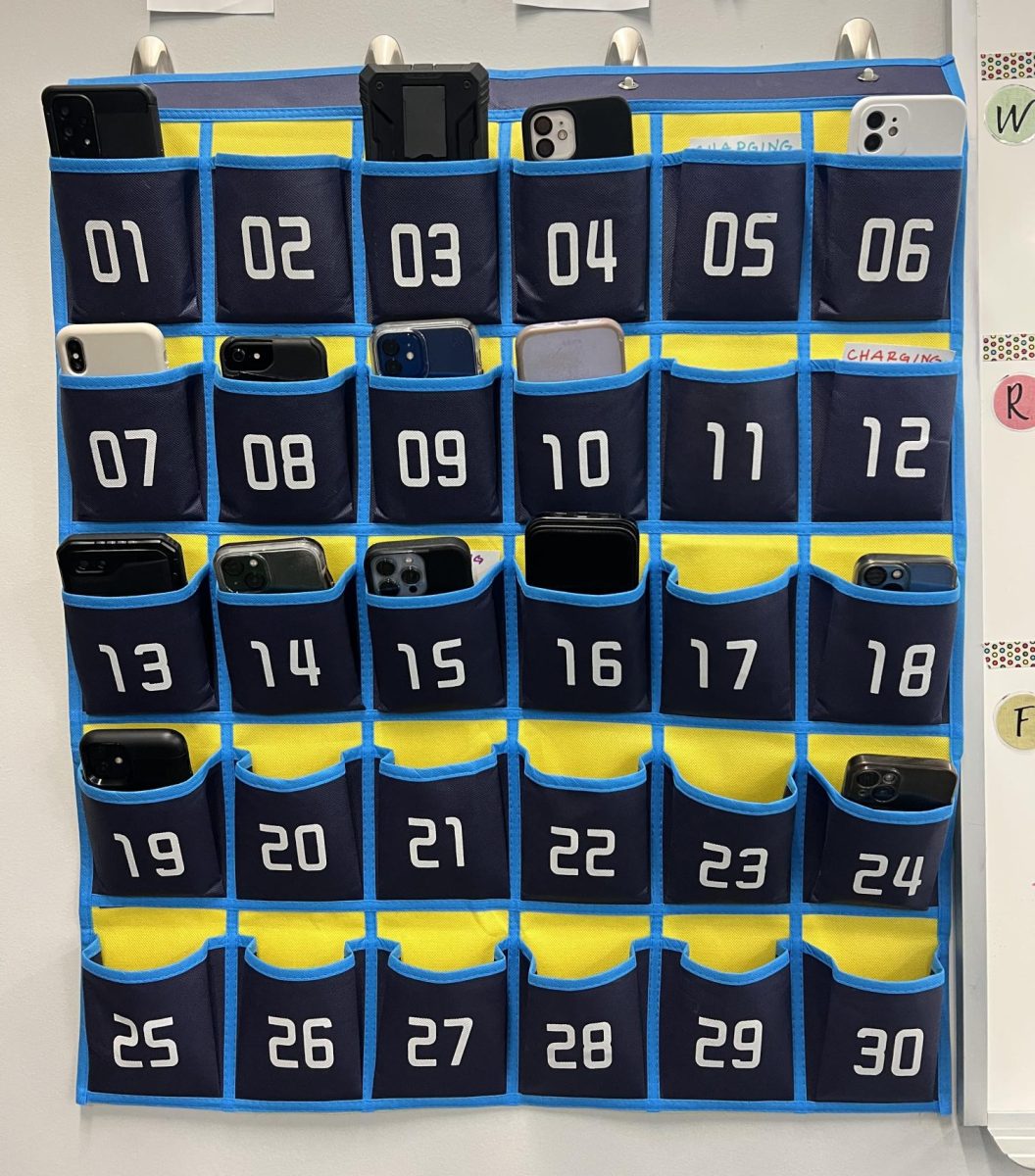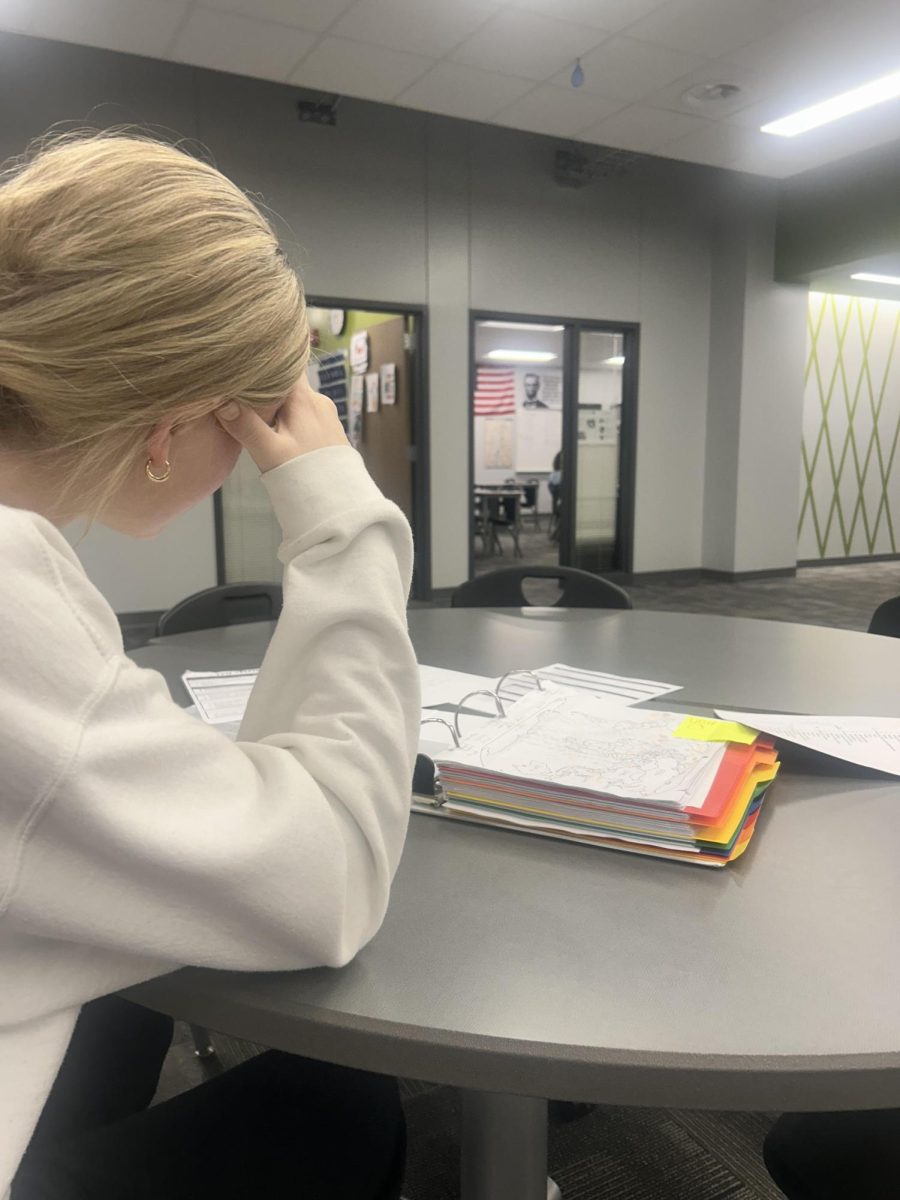The presence of mobile technology like cell phones, iPads, and smartwatches in everyday life has only increased within the last decade and the age at which this technology is utilized is consistently getting younger. While this is uncharted territory for many older generations, this is all America’s youth knows.
The Elkhorn Public Schools (EPS) district was established in the 1800s, with this there are several tried and true precedents that make Elkhorn such a successful school district such as DCAs, yearly preparatory ACTs, and high expectations. This being said, mobile technology poses a challenge that EPS has yet to determine a perfect course of action.
Current ENHS Solution
Phones have been a continuous debate in staff and administration meetings as some teachers noticed they were extremely distracting, so this year the conclusion was phones do not have a place in classrooms. Every teacher was instructed to require student phones be put up in caddies that hang in each room.
Principal Dan Radicia and the teachers at Elkhorn North deemed this change necessary due to the persistent and inappropriate use of cell phones in the classroom. Students were distracted, anxious, and lacked personal connections during work times.
“Social media platforms and notifications activate the brain to release dopamine that reinforces behavior to continue seeking out social interactions, which is highly addictive and distracts the brain from learning,” Radicia said. “I don’t want Elkhorn North students engaging in addictive behaviors that have caused an increase in anxiety and depression.”
ENHS School Board Luncheon Conversation
Unsurprisingly this topic was brought up at the annual luncheon when student council students and faculty eat with members of the school board. At this luncheon, administrators explained to Superintendent Dr. Bary Habrock and the school board the official policy and its progress.
Habrock confirmed that this policy is in place at all three EPS high schools and talked about the educational benefits of giving students a 52-minute break (the length of one class period) from their phones seven times a day.
“The current EPS practice of encouraging students to place phones in caddies or at minimum keep them out of sight, helps students focus on their learning, and minimizes disruptions to both individual students and those around them,” Habrock said.
According to administrators, this change has served its intended purpose so far. This time last year Assistant Principal Dr. Emily Christensen had received 27 phone referrals, which is when students are sent to the office for breaking a teacher’s cell phone policy. This year, she has received only three.
Students are simply unable to be on their phones when it is across the room on the wall, so teachers see fewer distractions and more focus from students. There is no doubt that this new phone policy has effectively kept kids off their phones in class, but the question truly remains whether this is in the best interest of students.
Differences in Generations
Perspective is created by experiences, and experience with phones differ greatly between the adults and students in the room. Phones are a significant part of daily life for people of all ages, but most adults grew up in a world where phones were not as easily accessible and could not function the way they do now.
In today’s world, children get smartphones at the ripe age of ten, sometimes even younger. Parents (specifically my own) often joke when they reprimand children through the confiscation of their phones, “Jeez, is your whole life on your phone?” As new and scary as this concept is, it’s true.
So much can be found on a 2” x 5” screen: world news, emails from superiors and clients, texts from family and friends, assignment updates on Google Classroom, and social media updates that keep users in the loop.
Adults may laugh or even be concerned at the stress exemplified by the younger generation when stripped of their technology, but these adults will never truly understand their attachment to technology. This attachment is not healthy and it can be detrimental to a teen’s mental health, but it is what the world has come to and it isn’t going away.
The idea and hope of Elkhorn faculty and the new phone policy is to decrease the desire students have to be on their phones, which is understandable.
“I hope that each and every student learns that life doesn’t revolve around social media and that they can learn self-control before college,” school board member Renee Vokt said. “It’s imperative that students, and adults, get back to the art of having in-person conversations.”
The district wants to intervene in this attachment and force students to take a break from their phones, but students see more value in being taught how to handle and reduce this addiction through practice and reinforcement rather than acting like phones don’t exist during school.
The Senior Perspective
The new phone policy was not taken on enthusiastically by the student body, especially the seniors, so student council co-president Allyson Dutoit voiced her concerns with the board.
“I explained to the board that a school-wide policy for phones is not the best method,” Dutoit said. “As a senior, it is important for us to learn self-regulation so we can take that skill with us to college.”
Phones have been proven to be distracting, however self-management and discipline are crucial skills that are necessary to succeed in higher education.
Cell phone addiction and accessibility will not go away once students leave high school, so there is value in teaching self-regulation.
Preparation for the future
Senior year is commonly a transitional period for high school students to learn about independence and life preparation. Those going on to further education have nine months of high school left to learn self-management, study skills, and general independence before they become freshmen at the collegiate level with little adult supervision and intervention.
College preparatory and Advanced Placement classes are rigorous courses that follow schedules, exams, and classwork similar to that of a college course. Many seniors take several hours’ worth of college credit, essentially making them mini-college students, yet these mini-college students turn in their phones to a caddy for every class period.
Students who meet course expectations at the college level should also be granted some independence at the college level.
As stated previously, college is an entirely different environment than high school. Students are in classrooms with hundreds of other students, professors care less about individual success, and parents are not there to hold college freshmen accountable for studying and completing assignments.
Phones are not taken in college, nor is there punishment for not paying attention. Instead, punishment comes in the form of grades and overall success, or lack thereof.
The ability to have a phone in possession and still listen, take notes, and participate in class is a critical skill that could make or break a student’s success. That being said, that skill does not just form overnight.
High school is the perfect environment to practice focus amid distractions because at this level teachers still care about an individual’s success. Now it’s unrealistic to suggest teachers allow students to blatantly sit on their phones, but the blanket policy to take them away strips students of self-discipline because it is being done for them.
Phone Effect on Social Interaction
Activities director Luke Ford briefly mentioned in the meeting that the classroom environment has been more engaging since the stricter policy was enforced, yet students like junior Alayna Vaughn do not entirely agree.
“If students are choosing to not engage with one another, they are looking to their computers when a phone is not available to them,” Vaughn said. ”Students who are engaging do so no matter if they have or don’t have their phones or computers.”
All technology provides a distraction for teens to turn to, but it is also worth considering there are just antisocial and social teens. People are quick to jump to the conclusion that phones keep teens from interaction and communication, but the truth is kids who enjoy conversing will continue to do so, and phones can expand said communication.
“My best friend and I have no classes together this year, yet we talk all the time,” Dutoit said. “Teachers like Mr. Ford may have noticed I’m on my phone instead of talking to those around me, but really I am probably communicating with my friends in a different way.”
My Proposition
Another subpoint in the luncheon phone conversation was the vast difference between a 14-year-old and an 18-year-old. The phone policy is consistent across the entire school, but different grade levels ought to be granted different freedoms.
Younger students may not be ready for this level of self-control, so I propose a four-tier system:
Freshmen should turn in phones for every single class, including study hall, and keep it up until the bell.
Sophomore year is the first year students can take an AP class, and it may be beneficial for them to spend their first AP course paying 100% attention. Therefore, they should turn in their phones at the beginning of every class, with the exception of study hall, and they can grab them during work time if teachers allow.
Many juniors take multiple AP classes so they should have the privilege of keeping their phones most days, but if a teacher deems a day of notes or work time is more important than normal they can require their students to put them up.
As for students not taking AP classes, it should be up to the teacher’s discretion. The workload tends to be lighter and at a slower pace than most APs, so 15-17-year-old juniors should be able to handle the class even with the possession of a distraction.
Seniors should have the benefit of their phones in their backpacks or face down on the desk every day, with the exception of test days. If it becomes a distraction, that privilege will be lost. Whether teachers only reprimand one student or the entire class for this mistake is based on the severity of the issue.
Mastery comes from habitual practice. Let young adults in the EPS district practice self-control while they still have the safety net of high school.










